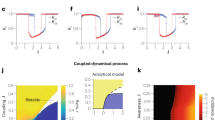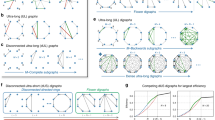Abstract
Real networks often form interacting parts of larger and more complex systems. Examples can be found in different domains, ranging from the Internet to structural and functional brain networks. Here, we show that these multiplex systems are not random combinations of single network layers. Instead, they are organized in specific ways dictated by hidden geometric correlations between the layers. We find that these correlations are significant in different real multiplexes, and form a key framework for answering many important questions. Specifically, we show that these geometric correlations facilitate the definition and detection of multidimensional communities, which are sets of nodes that are simultaneously similar in multiple layers. They also enable accurate trans-layer link prediction, meaning that connections in one layer can be predicted by observing the hidden geometric space of another layer. And they allow efficient targeted navigation in the multilayer system using only local knowledge, outperforming navigation in the single layers only if the geometric correlations are sufficiently strong.
This is a preview of subscription content, access via your institution
Access options
Subscribe to this journal
Receive 12 print issues and online access
$209.00 per year
only $17.42 per issue
Buy this article
- Purchase on Springer Link
- Instant access to full article PDF
Prices may be subject to local taxes which are calculated during checkout





Similar content being viewed by others
References
Kivelä, M. et al. Multilayer networks. J. Complex Netw. 2, 203–271 (2014).
Radicchi, F. & Arenas, A. Abrupt transition in the structural formation of interconnected networks. Nature Phys. 9, 717–720 (2013).
Bianconi, G. Multilayer networks: dangerous liaisons? Nature Phys. 10, 712–714 (2014).
Radicchi, F. Percolation in real interdependent networks. Nature Phys. 11, 597–602 (2015).
De Domenico, M. et al. Mathematical formulation of multilayer networks. Phys. Rev. X 3, 041022 (2013).
Szell, M., Lambiotte, R. & Thurner, S. Multirelational organization of large-scale social networks in an online world. Proc. Natl Acad. Sci. USA 107, 13636–13641 (2010).
Menichetti, G., Remondini, D. & Bianconi, G. Correlations between weights and overlap in ensembles of weighted multiplex networks. Phys. Rev. E 90, 062817 (2014).
Halu, A., Mukherjee, S. & Bianconi, G. Emergence of overlap in ensembles of spatial multiplexes and statistical mechanics of spatial interacting network ensembles. Phys. Rev. E 89, 012806 (2014).
Kleineberg, K.-K. & Boguñá, M. Evolution of the digital society reveals balance between viral and mass media influence. Phys. Rev. X 4, 031046 (2014).
Kleineberg, K.-K. & Boguñá, M. Digital ecology: coexistence and domination among interacting networks. Sci. Rep. 5, 10268 (2015).
Kleineberg, K.-K. & Boguñá, M. Competition between global and local online social networks. Sci. Rep. 6, 25116 (2016).
De Domenico, M., Solé-Ribalta, A., Gómez, S. & Arenas, A. Navigability of interconnected networks under random failures. Proc. Natl Acad. Sci. USA 111, 8351–8356 (2014).
Simas, T., Chavez, M., Rodriguez, P. R. & Diaz-Guilera, A. An algebraic topological method for multimodal brain networks comparison. Front. Psychol. 6, 904 (2015).
Boccaletti, S. et al. The structure and dynamics of multilayer networks. Phys. Rep. 544, 1–122 (2014).
Krioukov, D., Papadopoulos, F., Kitsak, M., Vahdat, A. & Boguñá, M. Hyperbolic geometry of complex networks. Phys. Rev. E 82, 036106 (2010).
Boguñá, M., Papadopoulos, F. & Krioukov, D. Sustaining the Internet with hyperbolic mapping. Nature Commun. 1, 62 (2010).
Papadopoulos, F., Psomas, C. & Krioukov, D. Network mapping by replaying hyperbolic growth. IEEE/ACM Trans. Netw. 23, 198–211 (2015).
Papadopoulos, F., Aldecoa, R. & Krioukov, D. Network geometry inference using common neighbors. Phys. Rev. E 92, 022807 (2015).
Serrano, M. Á., Krioukov, D. & Boguñá, M. Self-similarity of complex networks and hidden metric spaces. Phys. Rev. Lett. 100, 078701 (2008).
Papadopoulos, F., Kitsak, M., Serrano, M. Á., Boguñá, M. & Krioukov, D. Popularity versus similarity in growing networks. Nature 489, 537–540 (2012).
Boguñá, M., Krioukov, D. & Claffy, K. C. Navigability of complex networks. Nature Phys. 5, 74–80 (2008).
Papadopoulos, F., Krioukov, D., Boguñá, M. & Vahdat, A. Greedy forwarding in dynamic scale-free networks embedded in hyperbolic metric spaces. In INFOCOM’10: Proc. 29th Conf. on Information Communications 2973–2981 (IEEE, 2010).
Travers, J. & Milgram, S. An experimental study of the small world problem. Sociometry 32, 425–443 (1969).
The IPv4 and IPv6 Topology Datasets (Center for Applied Internet Data Analysis, 2015); http://www.caida.org/data/active/ipv4_routed_topology_aslinks_dataset.xml and https://www.caida.org/data/active/ipv6_allpref_topology_dataset.xml
Krioukov, D., Papadopoulos, F., Vahdat, A. & Boguñá, M. Curvature and temperature of complex networks. Phys. Rev. E 80, 035101 (2009).
Serrano, M. Á., Boguñá, M. & Sagués, F. Uncovering the hidden geometry behind metabolic networks. Mol. BioSyst. 8, 843–850 (2012).
Zuev, K., Boguñá, M., Bianconi, G. & Krioukov, D. Emergence of soft communities from geometric preferential attachment. Sci. Rep. 5, 9421 (2015).
Nicosia, V. & Latora, V. Measuring and modeling correlations in multiplex networks. Phys. Rev. E 92, 032805 (2015).
Min, B., Yi, S. D., Lee, K.-M. & Goh, K.-I. Network robustness of multiplex networks with interlayer degree correlations. Phys. Rev. E 89, 042811 (2014).
Kim, J. Y. & Goh, K.-I. Coevolution and correlated multiplexity in multiplex networks. Phys. Rev. Lett. 111, 058702 (2013).
Gemmetto, V. & Garlaschelli, D. Multiplexity versus correlation: the role of local constraints in real multiplexes. Sci. Rep. 5, 9120 (2015).
Serrano, M. Á., Buzna, L̆ & Boguñá, M. Escaping the avalanche collapse in self-similar multiplexes. New J. Phys. 17, 053033 (2015).
De Domenico, M., Lancichinetti, A., Arenas, A. & Rosvall, M. Identifying modular flows on multilayer networks reveals highly overlapping organization in interconnected systems. Phys. Rev. X 5, 011027 (2015).
Mucha, P. J., Richardson, T., Macon, K., Porter, M. A. & Onnela, J.-P. Community structure in time-dependent, multiscale, and multiplex networks. Science 328, 876–878 (2010).
Zhu, G. & Li, K. Web Information Systems Engineering—WISE 2014 Vol. 8786, 31–46 (Lecture Notes in Computer Science, 2014).
Loe, C. W. & Jensen, H. J. Comparison of communities detection algorithms for multiplex. Physica A 431, 29–45 (2015).
Fortunato, S. Community detection in graphs. Phys. Rep. 486, 75–174 (2010).
Lü, L. & Zhou, T. Link prediction in complex networks: a survey. Physica A 390, 1150–1170 (2011).
Clauset, A., Moore, C. & Newman, M. E. J. Hierarchical structure and the prediction of missing links in networks. Nature 453, 98–101 (2008).
Hristova, D., Noulas, A., Brown, C., Musolesi, M. & Mascolo, C. A multilayer approach to multiplexity and link prediction in online geo-social networks. Preprint at http://arXiv.org/abs/1508.07876 (2015).
Contreras, J. L. & Reichman, J. H. Sharing by design: data and decentralized commons. Science 350, 1312–1314 (2015).
Helbing, D. & Pournaras, E. Society: build digital democracy. Nature 527, 33–34 (2015).
Stark, C. et al. BioGRID: a general repository for interaction datasets. Nucl. Acids Res. 34, D535–D539 (2006).
De Domenico, M., Nicosia, V., Arenas, A. & Latora, V. Structural reducibility of multilayer networks. Nature Commun. 6, 6864 (2015).
Chen, B. L., Hall, D. H. & Chklovskii, D. B. Wiring optimization can relate neuronal structure and function. Proc. Natl Acad. Sci. USA 103, 4723–4728 (2006).
De Domenico, M., Porter, M. A. & Arenas, A. Muxviz: a tool for multilayer analysis and visualization of networks. J. Complex Netw. 3, 159–176 (2015).
Coleman, J., Katz, E. & Menzel, H. The diffusion of an innovation among physicians. Sociometry 20, 253–270 (1957).
Dorogovtsev, S. N. Lectures on Complex Networks (Oxford Univ. Press, 2010).
Acknowledgements
This work was supported by: the European Commission through the Marie Curie ITN ‘iSocial’ grant no. PITN-GA-2012-316808; a J. S. McDonnell Foundation Scholar Award in Complex Systems; the ICREA Academia prize, funded by the Generalitat de Catalunya; the MINECO project no. FIS2013-47282-C2-1-P; and the Generalitat de Catalunya grant no. 2014SGR608. Furthermore, M.B. and M.A.S. acknowledge support from the European Commission FET-Proactive Project MULTIPLEX no. 317532.
Author information
Authors and Affiliations
Contributions
K.-K.K. and F.P. conducted the research; all authors designed the research, discussed the results, and wrote the manuscript.
Corresponding authors
Ethics declarations
Competing interests
The authors declare no competing financial interests.
Supplementary information
Supplementary information
Supplementary information (PDF 7646 kb)
Rights and permissions
About this article
Cite this article
Kleineberg, KK., Boguñá, M., Ángeles Serrano, M. et al. Hidden geometric correlations in real multiplex networks. Nature Phys 12, 1076–1081 (2016). https://doi.org/10.1038/nphys3812
Received:
Accepted:
Published:
Issue Date:
DOI: https://doi.org/10.1038/nphys3812
This article is cited by
-
Geometric description of clustering in directed networks
Nature Physics (2024)
-
Greedy routing optimisation in hyperbolic networks
Scientific Reports (2023)
-
The D-Mercator method for the multidimensional hyperbolic embedding of real networks
Nature Communications (2023)
-
A comprehensive framework for link prediction in multiplex networks
Computational Statistics (2023)
-
An anomalous topological phase transition in spatial random graphs
Communications Physics (2022)



